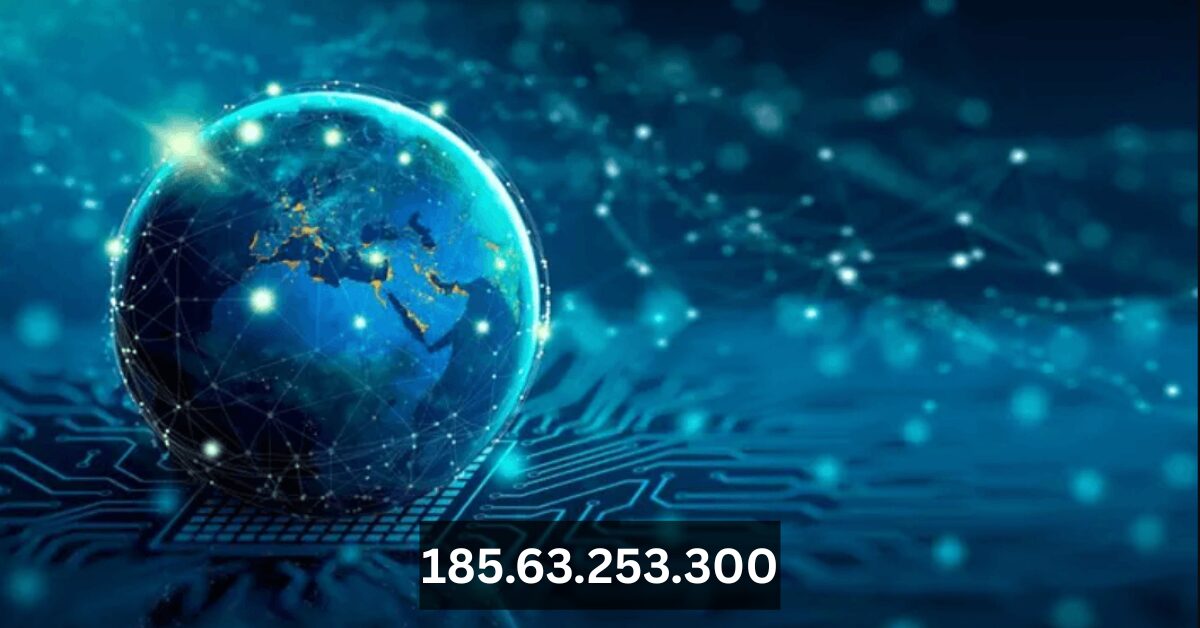People see strange IPs all the time — in logs, emails, or tutorials — and naturally want answers. The string 185.63.253.300 looks like an IP address at first glance, and curiosity drives searches like “185.63.253.300 IP address,” “is 185.63.253.300 real IP,” or “185.63.253.300 lookup.” That interest is useful: investigating odd entries is smart internet hygiene.
Right away, though, there’s a powerful takeaway: 185.63.253.300 is not a valid IPv4 address. That single fact reframes the whole investigation — and it’s precisely why this phantom IP is worth covering. In this post you’ll learn what makes an IP valid, why invalid IPs appear, how to investigate legitimate neighboring addresses, and what tools and practices professionals use for accurate, safe analysis.
Many searches are triggered by alarm: a suspicious string in a server log, an odd sender in an email header, or a mention in a forum. People type the number into search boxes hoping to identify malware, spam hosts, or the owner of the address. That instinct — verify before you act — keeps systems safer.
Others search out of curiosity or SEO interest. Researchers, instructors, or content creators may use the string as an example in guides. That’s why a clear, authoritative article about 185.63.253.300 helps redirect readers to accurate information rather than speculation.
IP addresses are fundamental building blocks of the Internet. Every device connected to an IP network is identified by an IP address so packets can be routed between endpoints. Modern network operations rely on IPs for geolocation, access control, logging, and forensic investigations.
Two major protocols exist today: IPv4 (widespread, 32-bit) and IPv6 (newer, 128-bit). IPv4 remains dominant for many systems and is the context for the string 185.63.253.300, which appears to mimic the IPv4 dotted-decimal format but violates its rules.
Understanding What an IP Address Really Is
The definition and purpose of an IP address
An IP (Internet Protocol) address is a numeric label assigned to devices participating in a network. It performs two main functions: identifying the host and addressing locality so routers can forward packets effectively. Think of it as a digital postal address for devices.
IP address are essential for everything from loading a webpage to receiving email and establishing VPNs. Network administrators and security teams monitor IP flows to detect anomalies like brute-force attempts, scanning, or data exfiltration.
How IPs route communication on the internet
When you request a webpage, your device sends packets to the server’s IP. Routers along the path use the destination IP to forward packets closer to the target. Tools like Traceroute visualize that path, showing each network hop and latency — useful when diagnosing connectivity issues or spotting routing anomalies.
Along with routing, protocols like DNS map human-friendly domain names to IPs, while firewalls and access-control lists enforce which IPs can reach services.
The difference between IPv4 and IPv6 formats
IPv4 uses 32 bits expressed as four octets (e.g., 185.63.253.45). Each octet must be in the 0–255 range. IPv6 uses 128 bits and hexadecimal groups (e.g., 2001:0db8::1). The two protocols are not interchangeable, and the formatting rules are strict — which leads us to why 185.63.253.300 fails.
What Makes an IP Address Valid or Invalid?
The structure of IPv4 (four octets, 0–255 rule)
IPv4 addresses are four decimal numbers separated by dots; each number (octet) represents 8 bits and must be between 0 and 255. If any octet falls outside that range, the address is syntactically invalid and no device can legitimately claim it on the public internet.
Therefore, 185.63.253.300 is syntactically invalid because 300 > 255. This is a non-negotiable rule in IP addressing.
Why “185.63.253.300” breaks the IPv4 standard
The final octet, 300, violates the octet range. Any tools that attempt to parse or use this string as an IPv4 address will either fail or reinterpret it incorrectly. This makes the string unsuitable for DNS records, routing tables, WHOIS queries, and legitimate geolocation.
Common causes of invalid or fake IPs in network logs
Invalid IPs may arise because of typos, placeholder text in documentation, obfuscation by actors wanting to avoid attribution, or faulty log parsing. Developers sometimes insert unrealistic values (e.g., 999.999.999.999) during testing. In other cases, log corruption or deliberate manipulation produces impossible numbers.
Exploring the 185.63.253.0/24 Range: The Real Context
Understanding IP blocks and subnet ranges
IP space is allocated in blocks (for example, a /24 covers 185.63.253.0–185.63.253.255). When investigating an impossible entry like 185.63.253.300, it’s useful to look at the valid block and the entities that operate within it. This gives real-world clues about legitimate traffic sources or potential abuse originating near that range.
Valid addresses near “185.63.253.300”
Addresses like 185.63.253.1 or 185.63.253.200 are valid and traceable. Examining neighbors can reveal hosting providers or services that might be misused by attackers. If your logs feature repeated attempts from 185.63.253.*, treat it as a pattern worth investigating.
Overview of the hosting region (RIPE NCC, Europe)
Ranges beginning with 185.63.253.* are commonly registered through regional registries such as RIPE NCC (the regional Internet registry for Europe). RIPE records and WHOIS data often list the organization, contact details, and technical points of contact for an IP block, which is crucial for reporting abuse responsibly.
Entities associated with the block (e.g., Hostpalace Datacenters LTD)
Some IP ranges are assigned to hosting companies or datacenter operators — for example, entities like Hostpalace Datacenters LTD might appear in registration data for a block. Understanding which organization controls an IP block helps investigators escalate issues to the right abuse contacts or ISPs.
Public vs. Private IP Addresses
Key distinctions and use cases
Public IPs are globally routable on the internet; private IPs (like 192.168.x.x or 10.x.x.x) are for local networks and not reachable directly from the global internet. Public IPs are the ones investigated in WHOIS lookups and blacklist checks.
Why 185.63.253.300 would be a public IP if it were valid
By structure, 185.63.253.300 mimics a public IPv4 address. If the final octet were within range, it would point to a public address allocated to an ISP, datacenter, or organization. Because it’s invalid, it cannot be a public IP and cannot resolve any resource.
How businesses and users interact with public IP ranges
Organizations manage public IP ranges for services like web hosting, email servers, VPNs, or proxy servers. Administrators use firewalls, CDN whitelists, and blacklists (e.g., Spamhaus) to control access and block malicious actors.
Limitations of IP geolocation accuracy
Geolocation accuracy varies; city-level data can be off. Many tools use databases that map IPs to the location of an ISP’s point-of-presence or datacenter, not the individual user. VPNs, proxies, and CDNs further distort location signals.
Understanding WHOIS Records for IP Blocks
What WHOIS is and how it works
WHOIS is a query protocol and database that stores registration details for IP blocks and domains. For IPs, WHOIS shows which regional registry control the range (like RIPE NCC) and the organization to contact for abuse or administrative queries.
How to check ownership and registration info
Use RIPE’s web interface or command-line WHOIS tools to retrieve registration records for a block (e.g., 185.63.253.0/24). A WHOIS record typically includes maintainer data, abuse contacts, and allocation dates — vital for reporting incidents.
Sample WHOIS output from the 185.63.253.0/24 range
A sample WHOIS extract for a valid address will show the NetRange, OrgName, CIDR, and abuse-mailbox. If you find malicious behavior, contact the listed abuse email or use the registrar’s web form.
Read Also: RPDJAFUD: Meaning, Technology, and Real-World Applications
Can 185.63.253.300 Be Used for Anything?
Why invalid IPs sometimes appear in test data
Developers and authors often include intentionally invalid IPs in documentation or test scripts to avoid accidentally referencing a real host. Invalid addresses also appear when someone obfuscates a number to prevent automatic link-following.
Use in documentation, simulations, or code examples
Invalid addresses are fine for demos and examples as long as they are marked clearly. For production systems, never hard-code invalid or placeholder IPs because they can break parsing logic or create false alarms in monitoring tools.
Risks of using invalid IPs in real-world systems
If improperly handled, invalid IPs can corrupt log formats, bypass filters, or confound security systems. Always validate input and sanitize log data to prevent injection of impossible values.
Security Implications of Invalid or Spoofed IPs
What IP spoofing is and why attackers use fake addresses
IP spoofing forges source addresses to hide origin or misdirect attribution. Attackers use spoofing in DDoS amplification, reflection attacks, or to evade simple IP-based access controls.
Signs of spoofed IPs in logs
Look for impossible patterns (e.g., invalid octets), inconsistent geolocation across requests, repeated attempts that map to known proxy providers, or mismatches between reverse DNS and WHOIS data.
How security systems handle invalid addresses
Modern security stacks validate inputs and ignore syntactically invalid IPs. Intrusion detection systems flag anomalies and contextualize them with other signals (user agent, timing, payloads). Blocking entire subnets or escalating to CERT may be warranted for sustained abuse.
Investigating Suspicious IP Activity: A Practical Approach
Checking your firewall and access logs
Start with your own logs. Note timestamps, request patterns, and any payloads. Correlate with authentication logs to spot brute-force attempts. If you see 185.63.253.* repeated, identify whether it’s a single host, multiple hosts, or a misconfigured scanner.
Tools like Wireshark, AbuseIPDB, and Spamhaus
Use Wireshark for packet-level inspection, AbuseIPDB to check community reports, and Spamhaus for blacklist status. IP Geolocation API helps map the IP to an ASN or provider. For path analysis, run Traceroute.
How to trace IPs safely and ethically
Always respect privacy and local laws. Don’t attempt to hack or probe third-party systems. Use passive reconnaissance — public WHOIS, blacklist checks, and contacting abuse contacts — and escalate to your ISP or CERT if you detect active threats.
Common Misconceptions About IP Tracking and Privacy
Why IPs don’t directly identify individuals
IP addresses identify network interfaces or endpoints, not people. Shared IPs (NAT), carrier-grade NAT, and dynamic assignments mean IP-to-person mapping is often inaccurate. Legal processes and ISP cooperation are required for precise attribution.
How VPNs and proxies alter perceived locations
VPNs and proxies route traffic through other hosts, making users appear in a VPN endpoint’s location. Malicious actors often use such services to mask their true origin, complicating investigations.
Privacy considerations when investigating IPs
Investigators should log minimally necessary data, avoid doxxing, and follow institutional protocols when contacting registrants. Sharing sensitive details publicly can harm innocents and breach privacy rules.
Real-World Example: Valid IP in the Same Range (185.63.253.200)
Example lookup results and hosting provider info
A valid neighbor like 185.63.253.200 will produce WHOIS and geolocation entries showing the managing organization and abuse contacts. You can check reputation on AbuseIPDB and Spamhaus to see if that specific host has prior reports.
How to compare with 185.63.253.300
Comparing a valid address to the impossible 185.63.253.300 illustrates the difference between actionable intelligence and noise. Focus investigations on valid addresses and subnet patterns rather than malformed entries.
Lessons learned from analyzing valid IPs
Investigations of real IPs often yield tangible remediation steps: blocking offending hosts, notifying abuse contacts, or tightening firewall rules. The key lesson is to ground action in verifiable data.
Best Practices for Network Administrators and Users
How to identify and block invalid or malicious IPs
Validate logs automatically and alert when impossible values appear. Use threat intelligence feeds, maintain an allowlist/denylist policy, and apply rate limits on authentication endpoints to hinder brute-force attacks.
Setting up firewalls and intrusion detection systems
Implement layered defense: edge firewalls, host-based IDS, and behavior-based monitoring. Tools should integrate with reputation feeds (e.g., Spamhaus) and allow quick blocking of malicious ASN ranges.
Reporting threats to ISPs or CERT authorities
When you confirm abuse, file an abuse report to the listed WHOIS contact or RIPE’s abuse forms, and escalate to national CERT if necessary. Provide concise logs and timestamps to speed remediation.
Frequently Asked Questions
Is 185.63.253.300 a real IP address?
No. It’s invalid because the final octet 300 exceeds the IPv4 range of 0–255.
Why do invalid IPs appear in system logs?
Common reasons include typos, placeholder/testing values, log corruption, or deliberate obfuscation by malicious actors.
Can IPs reveal someone’s exact location?
Generally no. IP geolocation shows the approximate location of the IP endpoint (ISP or datacenter), not the exact physical address of a user.
How can I report a suspicious IP?
Check WHOIS for the block’s abuse contact, use AbuseIPDB or Spamhaus to check reputation, and file a concise report with timestamps and logs to the ISP or CERT.
What’s the difference between spoofed and masked IPs?
Spoofed IPs are forged at the packet level (source address falsified). Masked IPs involve routing through proxies or VPNs to hide the original address.
Summary
185.63.253.300 is a useful teaching moment: it shows how quickly we can be misled by appearances and why validation matters. By learning the rules of IP formatting, understanding how to query WHOIS and reputation services, and using tools like Wireshark and Traceroute responsibly, you can turn curiosity into confident action.
Stay vigilant, document what you find, and escalate with evidence. Solid practices — not panic — build secure, resilient networks.



